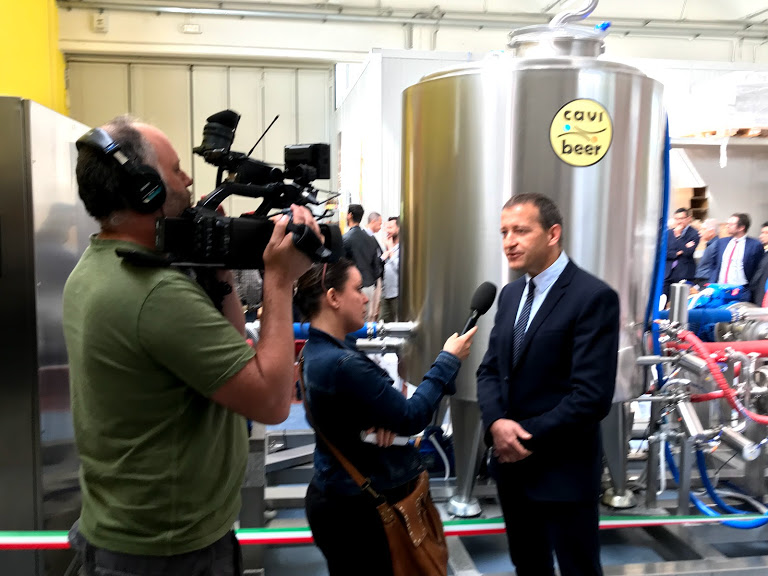 24-May-2018
24-May-2018-
Italy inaugurated today the world's first brewery using hydrodynamic
cavitation (
watch the video and photogallery).
Called "the technology which is about to revolutionize
beer-making" by
MIT Technology Review in 2016, the new technology has been developed by a joint team of Italy's Research Council led by physicist
Francesco Meneguzzo and subsequently transferred by Italy's RC to an Italian enterprise.
The latter enterprise has realized and installed the new brewing plant
at San Gimignano Brewery, a company making organic beers starting from
local ancient grains.
Compact -- the first industrial system has a 1,200 liter capacity -- easily managed and flexibly adapted to any beer recipes,
the new cavitation-based plant
entirely replaces the
existing technologies, unvaried since several centuries. Now, malt and
grains are introduced as such because cavitation pulverizes them
rapidly, whereas biling of the most is no longer required.
All crucial processes taking place during conventional boiling --
from microbiological control to loss of dimethylsulfide through
alpha-acid and arome extraction
from hops --
now take place at temperatures
below 100 °C.
Thereby, the new process halves the production time and almost
halves the enery requirements affording a beer which is richer in
health beneficial susbtances such as
prenylflavonoids, of longer duration and greatly reduced
gluten content.
The new process, furthermore, reduces the repetitive steps of the
conventional brewing enabling brewers to create new recipes by which
new beers are continuously produced and marketed to meet the increasing
demand of high-quality craft beers of different taste.
With a market of over
200 billion liter and turnover exceeding $593 million in 2017,
beer is the most popular alcoholic beverage in the world. Generally prepared using
four basic
ingredients
-- malted cereal grains, hops, water, and yeast -- beer is a refreshing
fermented beverage whose origin dates to the early neolithic period.
The market is projected to exceed $685 million by 2025.
A technology developed in Italy between Tuscany and Sicily
In the
inaugural study published in 2015 in
Energy
Science & Engineering the joint team comprised
of Lorenzo Albanese and Francesco Meneguzzo in
Florence along with Rosaria Ciriminna and Mario Pagliaro in
Palermo demonstrated the energy efficient inactivation of
Saccharomyces cerevisiae via hydrodynamic cavitation. In practice, the team showed that beer could be
pasteurized at much lower temperatures than in the conventional thermal treatment.
Since then -- in 4
studies which along with the first one comprise the
scientific foundations of the subsequent technological developments -- Italy's scientists first published in the
Journal of Cleaner
Production the
complete theory of cavitation-based brewing and the outcomes of the first experiments directly on pre-industrial scale, and then reported in
LWT
- Food Science and Technology the
discovery that the
gluten content in beer obtained via controlled hydrocavitation was lower than in the best gluten-free beers on the market.
The team went on reporting again in the
Journal of Cleaner Production the
discovery that the new process can be successfuly applied to raw unmalted grains from typical
old wheat varieties
leading to results comparable with traditional techniques but at a
fraction of the cost, opening a new way to increase the profitability
of craft microbreweries.
Finally, and again in
LWT
- Food Science and Technology, Italy's scholars
in
partnership with a team of University's of Palermo analytical chemists reported the
discovery that beer obtained via hydrocavitation has a
significantly higher amount
of
prenylflavonoids and
xanthohumol
in particular, namely the hops biophenols which have important health
beneficial properties.
Conventional brewing, on the other hand, greatly
reduced the amount of said flavonoids retained in the beer eventually
marketed.
Scientific papers
- Rosaria Ciriminna, Lorenzo Albanese, Vita Di Stefano, Riccardo
Delisi, Giuseppe Avellone, Francesco Meneguzzo, Mario Pagliaro, "Beer
produced via hydrodynamic cavitation retains higher amounts of
xanthohumol and other hops prenylflavonoids", LWT - Food Science and Technology
91 (2018) 160–167. https://doi.org/10.1016/j.lwt.2018.01.037
- Lorenzo Albanese, Rosaria Ciriminna, Mario Pagliaro, Francesco
Meneguzzo,"Innovative beer-brewing of typical, old and healthy wheat
varieties to boost their spreading", Journal of Cleaner Production 171
(2018) 297-311. https://doi.org/10.1016/j.jclepro.2017.10.027
- Lorenzo Albanese, Rosaria Ciriminna, Francesco Meneguzzo, Mario
Pagliaro, "Gluten reduction in beer by hydrodynamic cavitation assisted
brewing of barley malts", LWT - Food
Science and Technology 82 (2017) 342-353. http://doi.org/10.1016/j.lwt.2017.04.060
- Lorenzo Albanese, Rosaria Ciriminna, Francesco Meneguzzo,
Mario Pagliaro, "Beer-brewing powered by controlled hydrodynamic
cavitation: theory and real-scale experiments", Journal of Cleaner Production 142
(2017) 1457-1470. http://dx.doi.org/10.1016/j.jclepro.2016.11.162
- Lorenzo Albanese, Rosaria Ciriminna, Francesco Meneguzzo, Mario
Pagliaro, "Energy efficient inactivation of Saccharomyces cerevisiae
via advanced hydrodynamic cavitation", Energy Science & Engineering 3
(2015) 221-238. http://dx.doi.org/10.1002/ese3.62
Press and web coverage
TGR Toscana:
Servizio del 3 Giugno 2018/2
TGR Toscana:
Servizio del 3 Giugno 2018/1
Pianetascience.it:
Nasce tra Toscana e Sicilia il birrificio del futuro
Giornale di Sicilia:
Meno costi e più produzione, birra siciliana in tandem col Cnr
MIT Tech Review This
Technology is About to Revolutionize Beer-Making
The Crafy Pint Cavitation salvation
National Public Radio How The Food Industry Uses Cavitation, The Ocean's Most Powerful Punch
DRAFT Magazine The next round of beer innovations
Ozy.com The Latest Alcohol Trend: Brewing Like a Mantis Shrimp
Research Italy CNR at full…beer!
 24-May-2018-
Italy inaugurated today the world's first brewery using hydrodynamic
cavitation (watch the video and photogallery).
24-May-2018-
Italy inaugurated today the world's first brewery using hydrodynamic
cavitation (watch the video and photogallery).